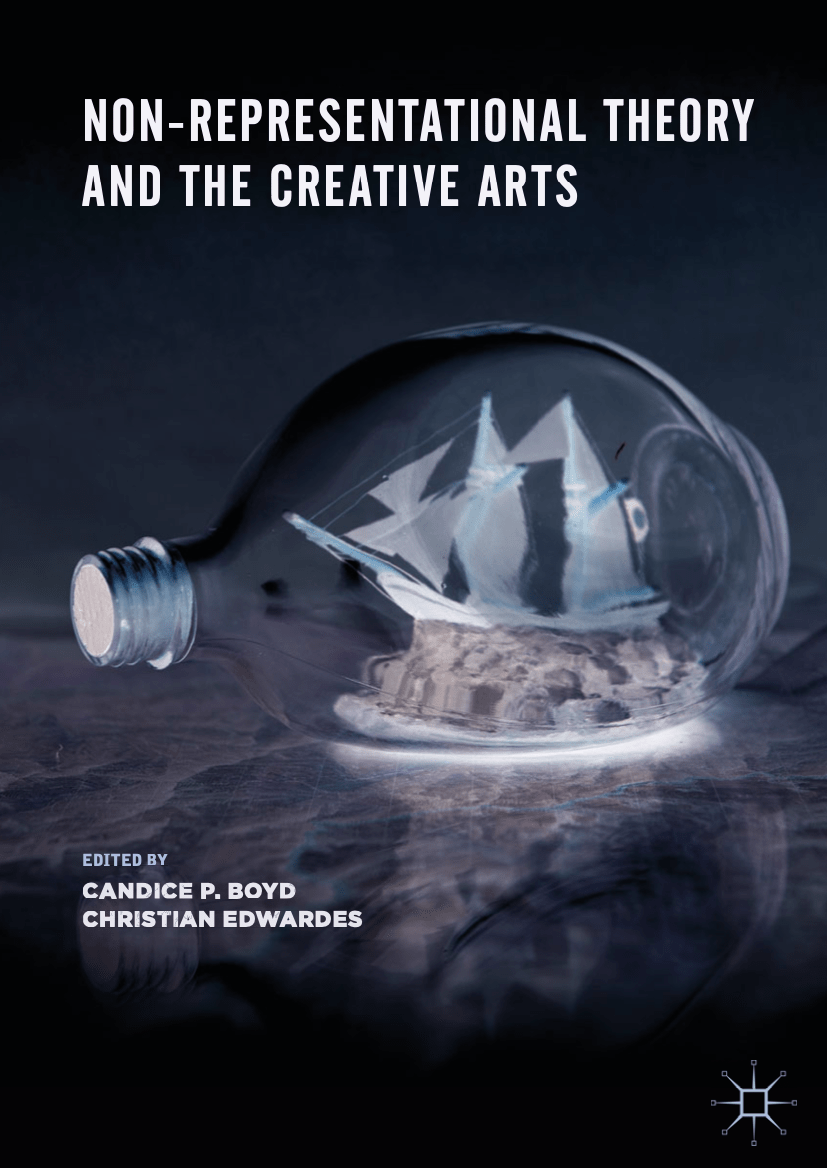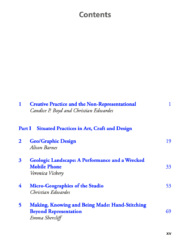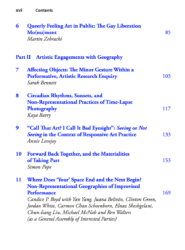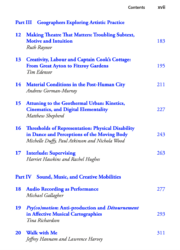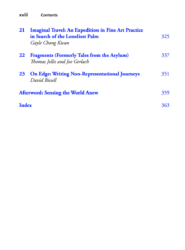Non-Representational Theory and the Creative Arts at the same time that concentrates on non-representation and its necessity in the contemporary world, with an eye on the concept of “space” lets artists and geographers with creative practices to introduce their interdisciplinary methods in art. The book has four main parts in which a group of artist-academics and geographers discuss their creative art/research—Part I, Situated Practices in Art, Craft and Design; Part II, Artistic Engagement with Geography; Part III, Geographers Exploring Artistic Practice; and Part IV, Sound, Music, and Creative Mobilities. The present summary, after the foreword and introduction, will turn the spotlight on an artist-researcher and introduce her practice as one.
In his foreword Non-Representational Dreams, Nigel Thrift has prominently pointed to the necessity for a change in the artistic practices and mentions that the human thinking does not conform to the picture or language models. He pays to the world’s nonconscious aspects with regard to a growing presence of the modern technology in everyday life, and accordingly, invites to recognize the nonconscious and think based upon it—a method which unleashes one from the explicit representation. The creative arts, relying basically on the performative and less instrumental methods, challenge the nonconscious state of the world and track the interface between showing and experiencing, sensing and understanding, enduring and living in the moment. The creative arts explore simultaneously the metaphysics, semantics and the epistemology of the nonconscious thinking and its representation. They treat time and space differently and glide from the sound to the sight and then to the smell and the specific body positions or mix them all together. The aesthetic discipline of the creative arts has new codes and signs. This new discipline, in contrast to other disciplines (such as market), is not a command from on high but a democratic and dialogical negotiation that pursues no absolute theorization. In politics, it seeks a new way of doing politics and the so-called para-political: “If there has been a determinedly instrumental application of non-representational theory, it has been in modern retail politics which injects itself into the flow of affect in order to produce swarms of partisan activity.”
In their introduction to the book, Candice P. Boyd and Christian Edwardes discuss Creative Practice and the Non-Representational. They consider the book to be about creative and experimental practices and their relation with the concept of the vital, emergent, transient and contingent space. Quoting Thrift, they call the non-representational theory as “the geography of what happens”: “It is interested in the ways in which life ‘takes place’ through movement, intensities and encounters.” Therefore, this theory is against any substance-based understanding, and instead, validates process-relational philosophies that posit the world constantly in movement. Thus, the writers see this theory as continue of vitalist thinkers such as Alfred North Whitehead, Gilles Deleuze, Brian Massumi, and Bruno Latour: “Forces and entities continually come in and out of relation in ways that are contingent, messy, and unpredictable but, at the same time, full of potential. Non-representational theory is an attempt to embrace life’s messiness without the need to contain or reduce it to a set of social constructions.” Non-representation and creative practice emphasize distancing from ‘a consciousness-centered core of self-reference.’ It seems as if there is more to the world than what is consciously understood, something based on a carnal, bodily and visceral understanding that is achieved by creative and material acts of ‘making sense’ as intervening in the world. Therefore, various practices in the creative arts (socially engaged, community-based art, dialogic art, littoral art, participatory, relational, interventionist, or collaborative art) unsettle the relationship between authorship and spectatorship to exert a broader philosophical critique to the unified subject.
Among 36 artists and cultural geographers (British and Australian) who have discussed their creative art-research practices in the book, we will focus on one project as an example: Alison Barnes with the subject Geo/Graphic Design. She investigates non-representational theory and creative methods in the fields of graphic design and print. Through her own project, Barnes unmasks aspects of graphic design and print which contrary to one’s common expectation are ephemeral, fleeting and immanence. According to Barnes, print and its associated materials and design is capable of representing embodied, multi-sensory and affective experiences of our everyday life and can inspire the spatial meanings. In fact, she defends the graphic design’s potentials for developing interdisciplinary studies based on the creative practices. In a creative approach, theory is privileged to the text. Barnes points to the typography of the words and considers it a ‘semiotic object’ rather than a mere physical entity which has potentials of creating meaning and being interpreted. Further, she mentions the psychological dimension of the text: It is highly reliant on the body, memory, recall, intersubjectivity, feeling, fear and anxiety, and they act together to create an embodied experience. To look, to listen and to touch act the same: “Thus our sensual, embodied encounters activate the relationship between these states and enable absence and associated memories to be brought into being.”
The creative work of art by Barnes is called Stuff (an Experimental Book). The main goal of Stuff is to emphasize the importance of personal, material possession in creating a sense of home. The title is also taken from “the stuff” we collect as mementos and keepsakes in the course of time. The experimental book of Stuff is also supposed to act as ‘sensory evocations’ of memories: through different types of paper stock, using embossed wallpaper design, covering images with glassine paper (similar to old family albums), etc. The reader is in fact able to bring their own experience to bear on the book and, precisely like space, to begin an individual journey: “[…] the memory is as rooted within place as it is within time and could be described as ‘sedimented’ within one’s body. However, rather than position such sensory memories as fixed in the way the term sedimentation might imply, they are repeatedly recreated through our embodied experience and are therefore remade in the present each time.”
_
Boyd, Candice P. and Christian Edwardes, ed. Non-Representational Theory and the Creative Arts. Singapore : Palgrave Macmillan, 2019.
 platform
platform  Non-Representational Theory and the Creative Arts
Non-Representational Theory and the Creative Arts
